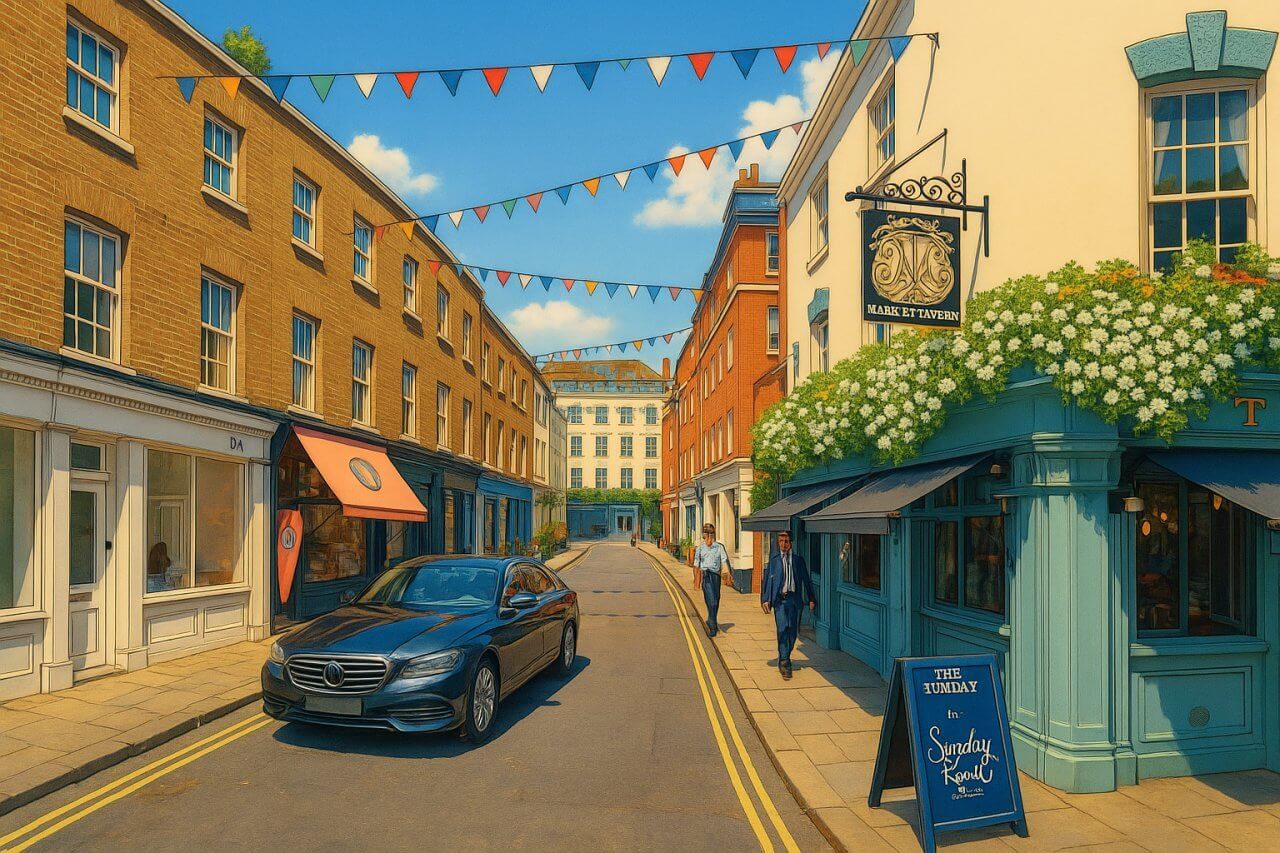
Shepherd Street, London
Shepherd Street is a short, characterful road in the heart of Mayfair, part of the prestigious City of Westminster in London. Connecting Stanhope Row in the west with White Horse Street in the east, this narrow thoroughfare offers a quaint and intimate escape from the busy streets of central London. The access from Stanhope Row is pedestrianised, giving the western end of the street a calm, almost village-like feel.
Location and Surroundings
Shepherd Street lies just to the north of Piccadilly and south of Curzon Street. It's nestled in a quiet pocket of Mayfair known for its charming mews, boutique hotels, and upscale residences. The street is part of a network of roads that includes White Horse Street, Hertford Street, and Trebeck Street, all converging near the historic Shepherd Market.
The area around Shepherd Street retains much of its 18th-century street plan, characterised by narrow lanes, low-rise buildings, and cobblestone textures that echo Westminster's rich architectural past. This micro-neighbourhood is steps away from some of the most luxurious and exclusive establishments in Greater London, yet it feels distinctly low-key and off the tourist track.
History and Origin of the Name
Shepherd Street owes its name and identity to Edward Shepherd, the architect and property developer who began constructing the area around 1735. Shepherd was responsible for creating the compact and quirky Shepherd Market, which was once the site of the annual May Fair from which Mayfair derives its name. The street and market were designed to bring a touch of order and charm to a previously rough and open fairground space.
Most of the buildings in and around Shepherd Street were completed by the late 18th century, with many later undergoing Victorian and modern renovations. The result is a streetscape that retains Georgian charm while accommodating discreet commercial and residential use today.
Character and Atmosphere
Shepherd Street exudes a quiet, village-like atmosphere, especially compared to the grand boulevards and major roads nearby. The pedestrianised western entrance from Stanhope Row ensures limited vehicle access, which helps maintain the peaceful ambience. The street is known for its subtle elegance and a handful of tucked-away pubs, cafés, and offices housed within converted townhouses and small buildings.
One of the most appealing aspects of the street is its human scale—buildings are typically three to five storeys high, with brick or stucco façades, traditional sash windows, and understated detailing. This setting has made it a favourite backdrop for film and television productions, particularly those seeking to evoke hidden corners of historic West End London.
Streets connected to Shepherd Street
- Carrington Street
- Hertford Street
- Mayfair Row
- Shepherd Market
- Stanhope Row
- Trebeck Street
- White Horse Street
Nearby Attractions and Sights
Shepherd Street is a stone’s throw from Shepherd Market, a picturesque enclave that offers small art galleries, wine bars, boutique restaurants, and tailors. The market square is a delightful spot for al fresco dining in warmer months.
Just a short walk away are some of London’s best-known landmarks:
- Green Park – A tranquil Royal Park ideal for walking or picnicking.
- Hyde Park Corner – One of London’s major junctions with access to Hyde Park.
- Berkeley Square – Famed for its plane trees and elegant Georgian buildings.
- St James's – The historic heart of royal and aristocratic London.
Transport Links
London Underground
The nearest London Underground stations are:
- Green Park Station – Served by the Jubilee Line, Piccadilly Line, and Victoria Line.
- Bond Street Station – On the Jubilee Line and Central Line.
- Piccadilly Circus Station – Served by the Bakerloo Line and Piccadilly Line.
- Oxford Circus Station – On the Bakerloo Line, Central Line, and Victoria Line.
Bus Routes
Nearby bus stops are found along Piccadilly, Park Lane, and Curzon Street, with routes offering connections across central London and toward the City of London. Common routes include the 9, 14, 19, 22, and 38, offering frequent services.
Real Estate and Property Prices
As of early 2025, real estate on Shepherd Street remains among the most expensive per square foot in Greater London. One-bedroom flats in the vicinity range from £1.2 million to £1.8 million depending on amenities and condition, with interiors typically measuring 600–850 sq ft (56–79 sq m).
Larger two-bedroom flats and penthouses can command between £2.5 million and £4 million or more, with some reaching upwards of 1,500 sq ft (139 sq m). This puts Shepherd Street firmly within the ultra-prime bracket of Mayfair real estate, significantly higher than the London average, which stands at around £700,000 for a similar-size property in 20251.
Fun Fact
Shepherd Street was once home to some of London's most notorious 20th-century spies and informants, including alleged meetings between intelligence figures during the Cold War. Its secluded nature, central location, and discreet properties made it an ideal location for clandestine activity, though few of these stories are officially confirmed.
Quick Facts
- Location: Mayfair, City of Westminster, London
- Connects: Stanhope Row (west, pedestrian access) to White Horse Street (east)
- Built: Mid-18th century, developed by Edward Shepherd
- Known for: Georgian architecture, tranquil atmosphere, hidden pubs, nearby Shepherd Market
- Nearby attractions: Green Park, Piccadilly, Berkeley Square, Hyde Park
- Nearest Tube Stations: Green Park, Bond Street, Piccadilly Circus, Oxford Circus
- Served by: Jubilee, Piccadilly, Victoria, Central, and Bakerloo lines
- Nearby bus routes: 9, 14, 19, 22, 38
- Property prices (2025): £1.2M–£4M+ depending on size (600–1,500 sq ft)
- Fun Fact: Linked to Cold War espionage activity due to its discreet locale
References
Map of Shepherd Street, London
 Painting of Shepherd Street, London (3 August 2019)
Painting of Shepherd Street, London (3 August 2019)